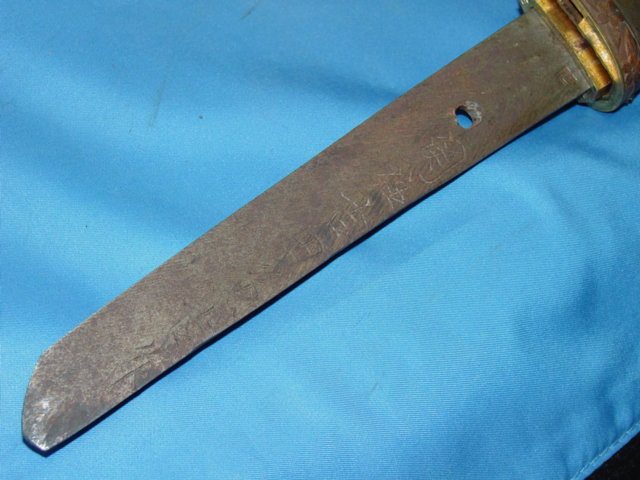SAMURAI SWORD 33 - WWII SEKI KATANA
This is a Japanese WWII Katana sword. As issued to members of the Imperial Army. The sword is outfitted with the
typical WW2 attire. The handle has a pommel cap made of metal and bearing the Chrysanthemum flower in three sides.
The left and right flanks are open and have a decorative contour. A hole has been drilled in the center and allows
the lanyard loop to pass through.
The scabbard consists of a metal shell over a wooden insert. A single suspension ring is attached via the use of a
metal band. The tip of the scabbard is capped with a metal drag.

The blade retains the original polish. There are no fatal flaws in it. The edge does not have any dents or cracks.
The tip area shows some scratches. The habaki is of WWII type construction. very plain in design.


|
The Samurai sword has a very rich history. The sword has been manufactured for several centuries and continues
to be produced today. The sword represented more than just a weapon. It was the soul of the Samurai warrior.
When attempting to identify the type of sword you have It is important to keep in mind that the fittings of
a sword (scabbard, handle, crossguard. etc.) may be identical from one sword to another. The reason why is
because during WWII the same fittings were used in all Army swords, Navy swords, etc. Armed forces are all
about uniformity. They strive to make everything the same.
This is the reason why a sword cannot be identified merely by its external appearance.
Understanding the different components that make up the Samurai sword is the first step in figuring out the
type of sword you have. That is the reason why we have created the
Understanding the Samurai sword section as a means to
provide a novice with the basic knowledge to start the path of determining the questions everyone has;
who made the sword, how old it is nad how much it is worth.
|



The following pictures shows the Seki stamp placed at the base of the tang. Seki was a factory in Japan that produced
a large number of swords during the war. The stamp is an indication that the sword was machine made. In other words
it was mass produced.

|
This page is a recognition and identification guide for Samurai swords.
Multiple detailed photos of a specific sample are provided. Descriptions point
out clearly defined points that should be noted.
One of the most commonly asked questions is "How much is my Samurai Sword worth?".
A price guide is included here to address this question. The value of the swords is
reviewed over a period of several years. A trend can be observed. The present worth
of the edge weapons in the collector's market is illustrated.
This service is provided free of charge to the visitor/enthusiast courtesy of
MilitaryItems.com,
a company dedicated to the preservation of military history and to providing quality
military antiques and collectibles to museums, institutions and the general public.
|
|


|
WE BUY JAPANESE SWORDS - All types of Japanese edge weapons. Whether it is a WWII era Samurai sword or an
older type of blade.
The process gets started by you sending us an
Email .
We will respond to your inquiry normally within 24 hours and in many cases much faster.
We can tell you what you have, what it is worth and how much we can pay you.
One sword or an entire collection -
Email Us .
|
 |

The sword has production numbers stamped in multiple components. The above photo shows the number 40 stamped at the
base of the handle. Additional numbers are hand written in pen.
The Tsuba and spacers are also marked with the number 40. The fact that all the parts bear the same number is an
indication that the sword has not been taken apart. The concept is known as "matchin numbers" and is more
desirable in a sword.

The Tsuba is of late war production. the inside section is solid as opposed to being hollowed out. The design shows
four Chrysanthemum flowers, one on each corner.
The metal ring is mounted at the base of the handle. It has a hole that allows the locking mechanism release button
to be exposed to the user. Pressing the button releases the lock which allows the sword to be pulled out of the
scabbard.
The sword is automatically locked when it is placed inside the scabbard. This is done for safety purposes.



The tang of the blade is signed on one side and green paint marked on the other side. The green paint are production
numbers that were written by the factory. The signature provides information about the location and person who
manufactured the sword.
The tang has a single hole drilled near the base. This hole is where the handle pin passes to secure the handle to the
blade. The end of the tang has an angle tone. The blade has not been shortened. It retains its original length.


By the Numbers
It is next to impossible to determine the exact number of Samurai swords that were produced and issued to
Japanese soldiers during the war. However, thanks to the record keeping maintained by the US Armed Forces,
it is possible to estimate how many swords were actually shipped home.
 |
There were over 500,000 Samurai swords were brought back home as souvenirs from the war.
There are several caviats to this number.
|
 |
For example, some soldiers took souvenirs and shipped them home circumbenting the established process.
Some of the swords were brought back inside duffle bags without anyone knowing except for the soldier who
captured the sword. This fact would clearly affect the final count.
The number also does not account for swords that were taken by Allied soldiers from other countries.
Collecting Samurai swords
Collecting Samurai swords is a field that has been growing since the days the GI's rummaged around Asia
bringing back military souvenirs. Japanese soldiers carried many of these swords when they went to
battle. Once the soldier was killed or captured, the Americans would take the edge weapons as war trophies.
Eventually all these pieces came back to the United States where military history enthusiasts began to collect them.
 |
In trying to determine if you should collect Samurai swords there are certain factors that should be
considered.
The adjacent table outlines some of the advantages and disadvantages of collecting the Samurai swords.
|
 |
This Samurai Sword may be currently reproduced.
It is becoming more difficult to be able to tell the fake ones from the real ones because
the quality of the reproductions is improving. The collector must become familiarized with
the construction style and materials employed in the manufacturing of this item.
Attention to the details is critical in order to be able to determine the authenticity of
the collectible.
If you have an interest is seeing other Japanese Samurai swords, you can do so by going to our
Japanese Samurai Swords Price Guide
identification guide. Where we cover Samurai swords from all periods.
| 




